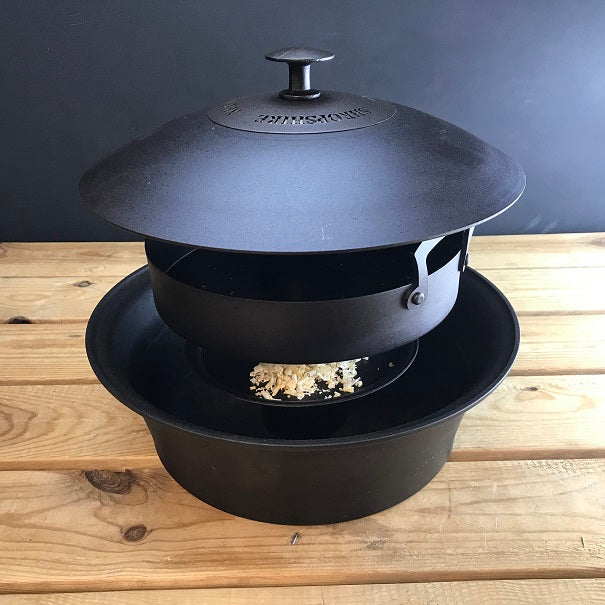Have an enquiry? Call us today on 0333 050 2911
Have an enquiry? Call us today on 0333 050 2911

The Language of Smoke: Fire Flavour Mastery
November 21, 2025 3 min read
Every fire speaks — but only a patient cook learns to listen. Smoke is the whisper between flame and flavour, the unseen element that binds wood, air, and food into one. To master open-fire cooking is to master this language — and to do that, you must learn its dialects: the pale blue of purity, the rolling white of impatience, and the bitter black of neglect.
In the modern world, smoke is often treated as a byproduct — something to avoid or control. But in the hands of a true firekeeper, smoke becomes an instrument. It softens, sweetens, and layers complexity. When wielded with care, it gives food a story that no spice or sauce can replace. When misunderstood, it ruins everything it touches. This is why learning to read smoke is essential for any warrior of the flame.
The Element Between Worlds
Smoke is born in transition — the space between fire and ash, creation and decay. Its colour, scent, and density all reveal the state of your fire. Thin, almost invisible smoke means your burn is clean and hot. Thick white plumes signal wood still drying. Bitter black smoke, rich with soot, is the mark of suffocation — too little air, too much impatience.
Different woods speak in different tones. Oak gives a deep, mellow voice — balanced and timeless. Beech burns steady, lending light sweetness. Cherry whispers fruit and warmth, while apple carries a perfumed touch of nostalgia. The wrong wood, though — pine, spruce, or resin-heavy fir — shouts over the food, leaving bitterness that lingers on the tongue and in the memory.
The Warrior’s Ritual: Controlling the Dialogue
- Choose your wood wisely. Every species carries its own flavour. Build a small wood library — oak for strength, cherry for sweetness, beech for balance. Mix them like notes in a song.
- Let your fire breathe. Smoke clarity is oxygen’s signature. Keep vents open and fuel dry. A healthy fire exhales gently — not in clouds, but in ribbons.
- Cook in the quiet phase. Wait until the flames fade to glowing embers and the smoke turns thin and pale. That’s when flavour speaks softly, not harshly.
- Embrace patience. The best smoke work happens slow. Resist the urge to add fresh wood mid-cook; let the ember bed carry the message.
- Watch, don’t guess. Your eyes will tell you when the smoke changes tone. Blue smoke kisses food with subtlety. White smoke carries moisture and muddles flavour. Black smoke warns of imbalance — fix it or start over.
This ritual isn’t just technique — it’s conversation. Fire, air, and wood are your teachers, and each cook is a lesson. Learn to balance them, and you’ll taste depth beyond seasoning — the essence of place, fuel, and patience.
The Smoke Within
To understand smoke is to understand restraint. The warrior who rushes the process fills his food with bitterness. The one who waits, listens, and adjusts learns harmony. Smoke is nature’s poetry — invisible discipline. It rewards calm hands and punishes arrogance. Each breath rising from the coals carries a memory of the forest, the craft of the cut, the rhythm of the flame. Honour that, and every meal becomes a ritual of gratitude.
Warrior’s Reflection
Fire shows you power; smoke shows you grace. Master both, and you master the balance between force and finesse. The lesson of smoke is simple but eternal — patience refines all things. Whether you’re cooking meat, building muscle, or forging character, the principle remains the same: don’t fight the process, guide it. The result will always be richer for your restraint.
Pictured product is the Hot Smoker and Roaster Oven Casserole Set by Netherton Foundry. Check out their full range here!
FAQ
Which woods are best for smoke flavour?
Oak and beech provide balanced, versatile smoke suitable for all meats. Fruitwoods like apple and cherry add sweetness — perfect for fish and poultry. Avoid resinous softwoods, which release tar and acrid fumes.
How can I tell when smoke is “clean”?
Clean smoke is thin and almost blue — it smells pleasant and fades quickly. Dirty smoke is thick, white, or grey and often stings the eyes. Adjust airflow or fuel when this occurs.
Does soaking wood chips improve flavour?
Not typically. Wet wood cools the fire and produces steam rather than flavourful smoke. Use dry, seasoned wood and manage heat instead — patience is your best seasoning.
DEBUG handle:
Continue your journey in the Warrior’s Kitchen: Discover open-fire recipes, ancestral cooking techniques, and foraged feasts built for resilience. Explore A Warrior’s Feast
Subscribe
Sign up to get the latest from the warrior's way blog, promotions and more
